|
< Earlier Kibitzing · PAGE 2 OF 2 ·
Later Kibitzing> |
| Apr-19-18 | | frogbert: I think my comment right after Mamedyarov-Carlsen finished was quite spot on: <frogbert: Looks like Ding-Wojtaszek has the most potential right now. Topalov-Radjabov will be a draw, and I suspect exchanges and simplifications in both Giri-Karjakin and Navara-Mamedov, even if the latter looks interesting at the moment.> |
|
| Apr-19-18 | | frogbert: Seemingly, 36... Nxg5? was black's decisive mistake. |
|
Apr-19-18
 | | Mateo: White has some pressure. However, it is very hard to see how he could win after 41...Ke7. |
|
| Apr-19-18 | | malt: 41...Kc8 (41...kd7 42.Bf7 |
|
Apr-19-18
 | | HeMateMe: what's the time difference from EST USA? About ten hours? |
|
Apr-19-18
 | | chessgames.com: I believe it's 8 hours. |
|
Apr-19-18
 | | HeMateMe: white will capture the g5 pawn, then anchor his Bishop on e6, play his King to H7-g8, put the Bishop on f7 so the next pawn can be captured? |
|
| Apr-19-18 | | norami: Korchnoi once took 45 minutes on the first move of the second time control. Can Woj beat it? |
|
| Apr-19-18 | | Marmot PFL: Fortunately I bet on both white and draw today and a black win seems unlikely. |
|
| Apr-19-18 | | Count Wedgemore: Interesting endgame. White wins if he escapes perpetual check. But can he? I think he can, eventually. But it will take many moves. First he needs to play 48.kf3. |
|
| Apr-19-18 | | BOSTER: White king in the open water.
My guess this is draw. |
|
| Apr-19-18 | | Count Wedgemore: <BOSTER> Perhaps you're right. I get a headache trying to calculate this! If White can find a way to block some of the checks with his bishop, there may be a way for him to get out of the perpetual. But it's complicated. |
|
Apr-19-18
 | | offramp: If Radoslaw Wojtaszek loses this game the other players will bully him. |
|
| Apr-19-18 | | Marmot PFL: Could be perp now, don't see escape from checks as if ever Kc7 Qd8+ |
|
| Apr-19-18 | | mike1: all that hard work and then you (White) play Ke3 instead of Ke2....
His endgame (especially Kg5-Lh5-Kg4 was astonishing; better than stockfish! |
|
Apr-19-18
 | | offramp: C7 is off limits, but there are 63 other squares to have a go at. |
|
| Apr-19-18 | | Marmot PFL: Black has two compensations for being a piece down
1) exposed WK
2) out of play WQ |
|
| Apr-19-18 | | Marmot PFL: Also the pawn chains block the king from escaping. |
|
| Apr-19-18 | | frogbert: Draw agreed. |
|
| Apr-19-18 | | 4tmac: 49. Ke2! (or even Kf2!? (I think)) win |
|
Apr-19-18
 | | AylerKupp: Stockfish's analysis leading to a win for White (part 1 of 2) I don't think that Ding Liren fully appreciated the zugswang possibilities of the position and he might have missed a win after 38...Kf8 by not playing 39.Bg6 instead of 39.Kg3. Black will shortly be in zugswang because after 39...Ke7 40.Bg7 White threatens 41.Bg8 and 42.Bd5 winning the Bb7. In spite of what Stockfish lists below, I think that White's king march is unnecessary until forced by ...g4 and (maybe) ...g3, in which case White wins a tempo by advancing its king while capturing Black's front g-pawn. This was Stockfish 9's top line analysis after 38...Kf8 39.Bg6:

click for larger view[+6.73], d=50: 39...Ke7 40.Kg3 (As I said above, I think that 40.Bh7 is better, threatening 41.Bg8 and 42.Bd5) 40...Kf6 (if this were played after 40.Bh7 the Bb2 would be lost after 41.Bg8 and 42.Bd5. An attempt to open up the k-side as in the game by 41...g6 fails after 42.Bd5 gxf4 43.Qxb7 Qxb7 44.Bxb2 and Black is lost after either 44...f4 (Stockfish eval [+5.74]) or 44...fxg4 (Stockfish eval [+67.65]), both at d=33.
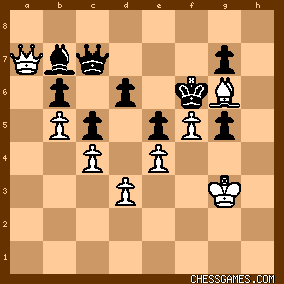
click for larger viewContinuing with Stockfish's line:
41.Kg4 Ke7 42.Kxg5 (and here I think that 42.Bh7 was better, forcing 42...Kf8 and not allowing 42...Kd8 protecting the Qc7. It is to White's benefit to keep the k-side closed as much as possible to prevent Black's queen from penetrating after giving up the Bb7) 42...Kd8 43.Kh5 (43.Bh7 was also possible and Stockfish at d=41 evaluates the resulting positions all at [+4.65], after 43...Kf8, 43...Kf7, and 43...Kf6 respectively)
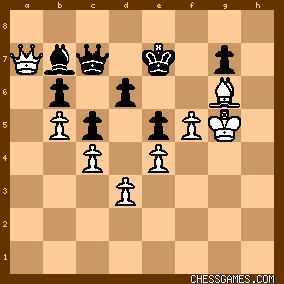
click for larger view42...Ke7 44.Kg4 Kd8 45.Bh7 (finally!) 45...Ke8 46.Bg8 g6 47.Bd5 gxf5+ 48.Kf3
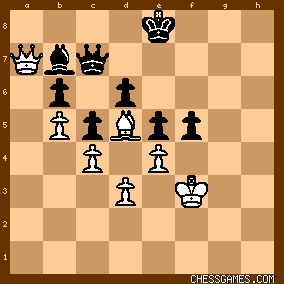
click for larger viewBest. 48.Kxf5?? loses immediately after 48...Bc8+ and 48.exf5 lets Black's queen out leads to a draw by repetition after 48...Qg7+ 49.Kh5 Qh7+ 50.Kg4 Qg7+ etc. 48...fxe4+ 49.Ke2 (an epic king retreat!) 49...Qc8 50.Qxb7
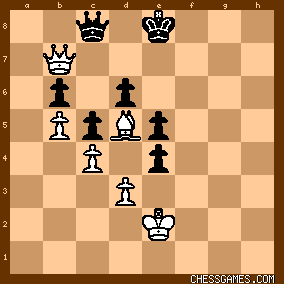
click for larger viewNot too dissimilar a position to what could have occurred in the game had White played 50.Qxb7 instead of 50.Bxb7 in the actual game.
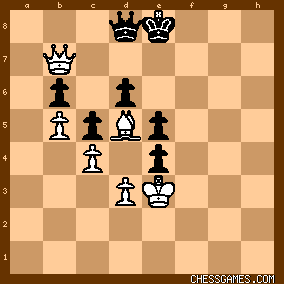
click for larger viewI think that 50.Qxb7 is better than 50.Bxb7 (in either position) because White's bishop remains in its commanding position on d5 and White's queen has much more mobility along the 7th rank. But in the game continuation Stockfish at d=38 evaluates both 50.Qxb7 and 50.Bb7 at [0.00], whereas in this line Stockfish at d=37 evaluates 50.Qxb7 at [+5.26] and 50.Bxb7 at [0.00]. What's the difference? Well, in the game continuation Black has 50...Qg5+, cutting off White's king from immediately gaining shelter on the q-side while in the hypothetical line Black's 50...Qg4 allows 51.Kd2 and safety on the q-side. Of such minor differences are games won or drawn! Of course, there was no way that Ding Liren could have calculated this back on move 39! But the fact that the position reached after 42.Bh7 was not all that different than the actual game continuation after 42.Kxg5 indicates to me that this long Stockfish line was not that unreasonable. |
|
Apr-19-18
 | | AylerKupp: Stockfish's analysis leading to a win for White (part 2 of 2) Continuing with Stockfish's line:
50...Qg4+ 51.Kd2 Qf4+ 52.Kc2 exd3+ 53.Kxd3 Qf1+
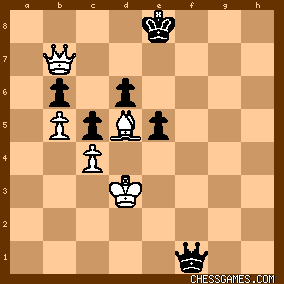
click for larger viewIt's still not unreasonable to think that Black might achieve a draw by repetition but the line continued: 54.Ke3 Qh3+ 55.Ke2 Qh5+ 56.Kd2 Qh2+ 57.Kd3 Qg3+ 58.Kc2 Qf2+ 59.Kb3 Qg3+ (maybe 59...Qe3+ keeping the queen closer to White's king was better? No, after 60.Ka4 Black has no more checks either way, and Stockfish evaluates the resulting position at [+6.89], d=37)
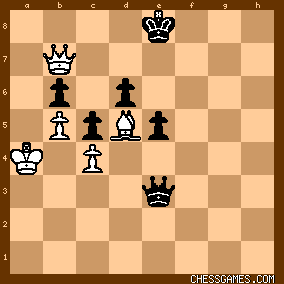
click for larger view60.Ka4 Qg6 61.Qc8+ (now it's White turn to start checking) 61...Ke7 62.Qc7+ Ke8 63.Bc6+ Kf8 64.Qd8+ Kg7 65.Qe7+ Kh6 66.Qh4+ Qh5 67.Qf6+ Qg6 68.Qxg6+ Kxg6 (an apparent finesse in Stockfish's part. 66...Qh5 seemed to me like an odd decision since the K+B+P vs. K+P ending seems completely lost for Black even with 2Ps for the bishop. But if instead of 67.Qf6+ White had played 67.Qxh5+ then after 67...Kxh5 Black's king would have wound up on h5 whereas after 67.Qf6+ Qg6 68.Qxg6 Kxg6 Black's king would have wound up on the less favorable square, g6, with regards to penetrating White's k-side. And if 66...Kg7 then 67.Be4 forces the queen trade anyway after 67...Qf7 68.Qh7+ K(any) 69.Qxf7 Kxf7 Black's king winds up in the even more unfavorable square, f7.
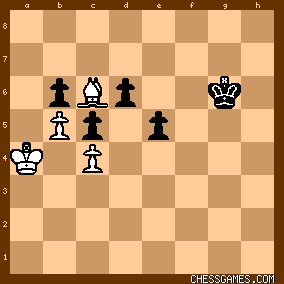
click for larger view69.Kb3 Kf5 70.Kc2 Ke6 71.Kd3 Kf5 72.Be4+ Kg4 73.Ke3 Kg5 74.Bb7 Kg4 75.Bc6 (75.Ke4 and the capture of the Pd6 seems faster and Stockfish detects the win immediately using the Syzygy tablebases but it takes it until d=44 (admittedly only a little bit over a minute on my slow computer) before it's regular evaluation function detects a mate in 19 or less for all Black responses. But at this point I'm just quibbling.
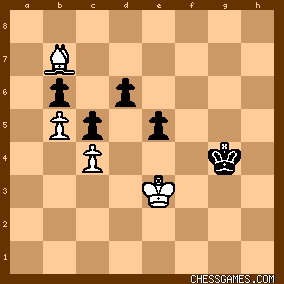
click for larger viewThe rest (thankfully!) of Stockfish's line:
75.Bc6 Kf5 76.Bd5 e4 77.Bxe4+ Kg4 78.Bf3+ Kf5 79.Bc6 Ke5 80.Bd5 Kf5 81.Bf3 Kg6 (why not 81...Ke4 with an attempt to stay on the dark squares? Because at d=44 Stockfish then indicates a mate in 22 for White after 82.Be4) 82.Kf4 d5 83.Bxd5 (and this is a theoretical tablebase win for White in 17 moves) 83...Kh5 84.Ke5 Kg5
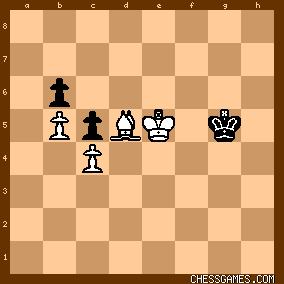
click for larger viewWhite gobbles up Black's q-side pawns and promotes one of his pawns for an easy win. I do think that there are a lot of questionable time-losing moves by Stockfish and that White could have won quicker but maybe there are subtleties that escaped me and the moves given were required in order to achieve mate the quickest possible way. |
|
| Apr-20-18 | | Imran Iskandar: Excellent work, <AylerKupp>. It would have been incredible if Ding managed to win the endgame, and this game likely would have been remembered as an endgame classic. |
|
| Apr-20-18 | | Ulhumbrus: How about the following idea.
In the position after 34...Qc7 suppose that White plays d3-d4. Then ...cxd4 displaces the c5 pawn and allows Bb4 attacking the d6 pawn while ...exd4 displaces the e5 pawn and allows Bf4 attacling the d6 pawn. In the event of Bb4 White Would like to play Qa3 and overpower the d6 pawn , while in the event of Bf4 White would like to play either Qg3 or Qh2 and overpower the d6 pawn. This suggests the question: From which square can the White queen do to both a3 and either g3 or h2? One square is a2, as from a2 the queen can go to a3 or h2. This suggests preparing the advance d3-d4 by Kf1 clearing the second rank and Qa2. |
|
Apr-20-18
 | | AylerKupp: Thanks <Imran Iskandar>. I think that I actually saw the winning idea almost immediately but I don't think it took much thinking to realize that with Black's bishop immobilized and the Black queen restricted to guarding both it and the Pb6, zugswang possibilities were likely, and that White had free rein on the white squares on the k-side. So maneuvering with the bishop was a possible way to win, and that it might as well be tried as soon as possible, with no delay with king moves. After all, White had practically no losing chances, so it might as well be tried. Then again I had just gotten up (an 11 hour time difference between Baku and Los Angeles) and was looking at the game fresh, and not tired from several hours of playing, concentration, and preconceived ideas. But of course I would never have been able to find the proper sequence of moves in a million years. And, as Stockfish's analysis shows, there were many possibilities for a draw and even a loss by White. In my infinite wisdom and inversely proportional playing strength the latter was the one course that I probably would have chosen. |
|
 |
|
< Earlier Kibitzing · PAGE 2 OF 2 ·
Later Kibitzing> |





